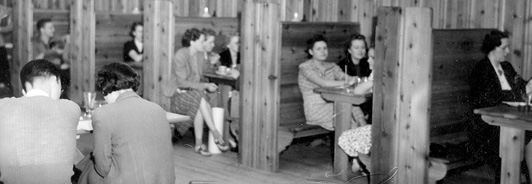Mail Bag
Is a College Degree Worth It?
I read with interest UNC President Kay Norton’s comments in the spring/summer edition of Northern Vision on the question: “Is a college degree worth it?”
I have to admit that when I was a full-time graduate student at UNC back in 1974-75, I asked myself that same question.
The scenario was that I left my job as a school superintendent in northwest Nebraska to complete the doctoral residence requirement.
Here I was with a wife and four small children, a nonresident student and no job. I was fortunate to have received an Educational Planning Service fellowship through the Department of Educational Administration that paid $317 a month. It was great to be young and stupid. Otherwise, I might not have “taken the plunge” so to speak.
At any rate, my degree from UNC was definitely worth the investment. And the education I received through the Department of Educational Administration was truly outstanding. Although they are no longer living, a couple of the professors that stand out are Dr. Art Partridge and Dr. Emmett Ritter. There are others, of course, but these two stand out as the best in their field.
— R. L. “Bob” Ripp, (EdD-80), director, Early Learning Academy Lexington (Neb.) Public Schools
Visit the archives to read Norton’s answer to the question in the spring/summer edition of Northern Vision.
Co-ed McCowen Hall to Jackson Married Student Housing
1963-1967
My earliest encounter with my wife was as a freshman at McCowen Hall, the first “co-ed” dorm at Colorado State College. Co-ed in those days meant two dorm buildings separating the sexes with a lounge and dining area in between—think of it like a structure in the shape of an “H”—with residence hall guards on each side, particularly on the girls side. Judy was a sophomore and a hostess for the dining room and had specific duties for monitoring the Wednesday evening, somewhat formal, family-style dinners, including the dispensing of rules of etiquette and determining when the banquet partakers of a cleared table could disperse and be on their way (similar to the roles of elementary school lunchroom aides). My AKL pledge brothers and I would retaliate in a correspondingly childish but comparable way by sneaking out of the dining room on our hands and knees before it was signaled we could appropriately leave.
Despite what could be described as these less than promising romantic circumstances, we started dating—of course I always had to get her back to her side of the dorm by the 11:00 p.m. curfew (or was it 10 p.m. except for weekends?). Eventually, at an AKL rush party, we got “lavaliered,” then “pinned,” and finally engaged. Judy was working in the dining hall to help pay for her education and I was using my father’s GI Bill (as his sole surviving son) to go to school. We thought we could get by on my stipend and proceeded to marry in the summer of 1965, me looking forward to being a Junior at CSC and Judy a Senior.
It wasn’t until we returned from our honeymoon (basically a road trip to Manitou Springs and a few rounds of miniature golf) that we received notice that we had been selected to fill a vacancy for a one-bedroom apartment at the distinctly-named Jackson married student housing “projects” (my word). The Jackson apartments were old “prisoner of war barracks” (I assumed “relocation” barracks during WWII) directly to the east of the football stadium, which was nice on football weekends as we inched across a ditch on some beam supports to enter the sports ground from the backside. The rent, as I recall, was $36.50 a month, furnished, with all utilities paid. Unsurprisingly, the furnishings consisted of army cots for a bed and a greenish-synthetic-vinyl-like couch in the living area that could be pulled out into a downright uncomfortable bed—I do not recollect any additional furniture other than perhaps an especially small kitchen table and 2 chairs to go with it. Judy remembers the undersized refrigerator and the very tiny gas stove with an oven that would barely accommodate a medium-size baking dish. The winter chill was warmed with the single gas-fired heater located near the center of the apartment (air conditioning was not available during the summer months, not even a window unit). And, of course, there was the railroad track, which seemed not more than 15 yards from the back door.
Our first night in the Jackson apartment was spent with humble anticipation and a touch of reticence. We chose to attempt sleep on the sticky green pullout couch rather than the army cots (days later we got a used mattress and frame from my parents). As the dawn was breaking the next morning, a faint vibration began creeping into our consciousness, then came a slow tremble, and finally the wakefulness of a low earthquake-like rumbling of a mechanized monster trying to slip unnoticed through a populated neighborhood—yes, it was our initial experience with the regular transitory passing of a train. It seems cliché to say, but we got used to it and after awhile it became a reassuring event, establishing some level of constancy for us.
Other experiences encountered in the Jackson apartment deserve mentioning such as: the constant effort to extinguish communities of roaches infiltrating the kitchen area; the call from Judy during a fraternity meeting for me to rush back to the apartment to capture a field mouse that had ensconced itself under the kitchen sink; the joke that we could easily punch a hole in the wall next to the kitchen table, reach through, and share the salt and pepper shakers with our neighbors; at night, the light from our neighbors (both sides) shining through the seams of the walls and corners of the apartment; and the lack of any kind of noticeable sound abatement between the apartments, which meant on occasion, without intention, we collectively heard various frustrations and intimacies with our common neighbors. We made the most of it though. We tried to decorate and make the place as homey and comfortable as we could—a cut and varnished tree trunk stump for an end table, a spray-can painted old floor-based oil burner intended to have the appearance of a miniature pot-bellied wood burning stove, a large gaudy “goldish” stained ceramic candlestick (no, I don’t know why we got it, but we still have it today), and other knick-knacks obtained from our parents.
One time, our good friends who lived in another apartment down the way in Jackson (he and I were fraternity brothers) decided they needed to do something different with their 4x8 panel divider between their living room and kitchen and Judy and I offered to help them wallpaper it to give it a little more class. (Or were we over there visiting and having a few drinks when it was decided it was time to do something about the boring wall screen right then and there?) How hard could it be to wallpaper a 4x8 piece of plywood? It’s not like we were attempting a fresco or anything. Yet, as us guys continued in the partying mode and began toiling away, slopping on paste and putting up sheets of wallpaper, we could never get it aligned correctly or placed smooth without major wrinkles. The girls were of no help and just sat on the plastic couch and snickered. Eventually, we gave up and Judy and I went back to our own apartment. The next day, though, it was discovered that the revelry-induced effort at wallpapering didn’t turn out half-bad—after it had dried in place, it seemed fairly well lined up and wrinkle-free.
Many friends we had in McCowen Hall and Jackson apartments are still our friends today—all in all, it was good times never to be forgotten even as our memory fades. Judy and I graduated while living in Jackson. Judy taught special education in Gilchrest and I continued in graduate school. And we moved out of the college-managed housing we had experienced together and moved into an apartment away from campus. Only this time I didn’t have to sneak out on my hands and knees.
— Charles (Chuck) Russell (BA-67; MA-68)
— Judy Mattingly Russell (BA-66)
Email your campus memories to northernvision@unco.edu.







